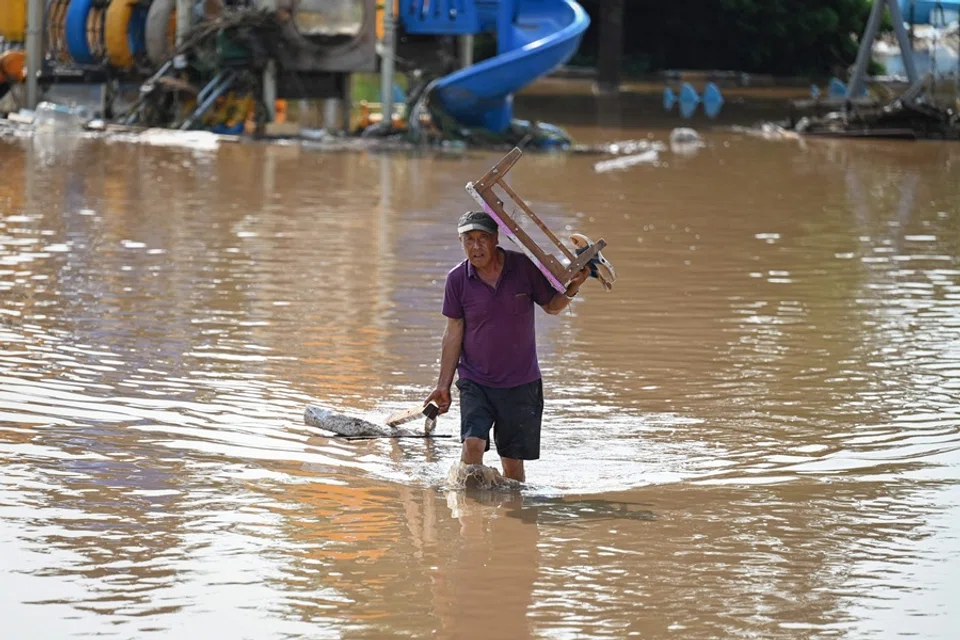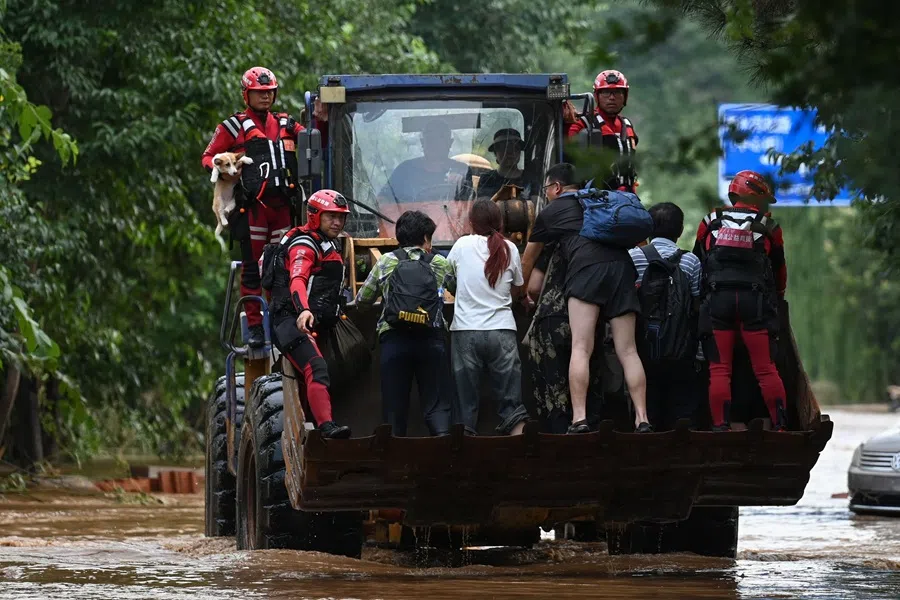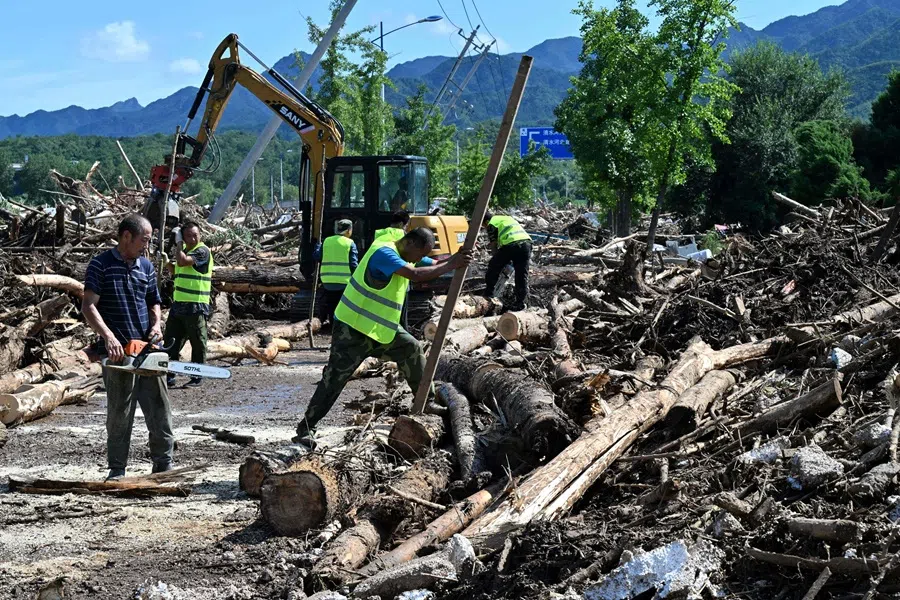Beijing’s flood came for the elderly first
Heavy rains in Beijing have left at least 44 people dead, most of them elderly and infirm. Despite official reports of evacuations, residents in Miyun district said they woke up to knee-high waters and had to leave on their own. Lianhe Zaobao senior correspondent Chen Jing assesses what more can be done.

Of the 44 people who died in Beijing’s torrential rains over the past week, 31 were from a nursing home in Taishitun town, Miyun district.
Even more shocking than the official report were the images shared by netizens and the media from the suburban nursing home.
In a video circulating online, an elderly resident trapped inside was seen helplessly waving for help by the window as floodwaters rose outside.
Photos taken by Caixin after the water receded showed wheelchairs submerged in mud-filled hallways. Beds were overturned, watermarks on the walls reached above the wardrobes, and muddy handprints were still clearly visible.

At a press conference on 31 July, officials stated that Miyun district was the hardest-hit area during the recent torrential rains, with Taishitun town being the most affected area. The nursing home is located on Taishitun Street, upstream of the Miyun Reservoir. On 28 July, the day of the disaster, 77 people were inside the facility, including eight staff members and 69 elderly residents, 55 of whom were either fully or partially disabled.
According to victims’ families, most residents were elderly individuals with limited mobility. Those who survived were generally able to walk and “tried all ways to climb onto windowsills or chairs”.
... the nursing home was located in a town centre area that has always been considered as “safe”, so contingency plans did not include it in evacuation efforts. — Yu Weiguo, Party Secretary, Miyun district
‘Safe’ zone?
At the press conference, Yu Weiguo, party secretary of Miyun district, choked up, noting that the elderly victims were around the same age as his own parents, yet were taken away by the torrential rain disaster. “We are deeply saddened and heartbroken,” he said.
Yu acknowledged that the nursing home was located in a town centre area that has always been considered as “safe”, so contingency plans did not include it in evacuation efforts. He admitted, “This shows that there are still gaps in planning, and that we have inadequate awareness of extreme weather events.”

Despite his sincerity, netizens quickly pointed out a logical fallacy: since Miyun Reservoir is a key part of Beijing’s flood control system, and there are over 50 disabled elderly residents living nearby, the nursing home should have been designated as a high-priority flood protection site. Why was it not evacuated first?
Residents living near the nursing home told the media that the nursing home was actually located in the area’s lowest-lying spot — contrary to official claims that it was “safe”. According to Caixin, after the disaster, floodwaters in nearby homes — even those closer to the river — peaked at 1.5 metres, while inside the nursing home, the water rose over 2 metres.
Insufficient efforts by authorities?
Moreover, the heavy rains in Beijing began on 23 July, and Miyun district had issued a red alert for torrential rains on the evening of 26 July. Before the incident on 28 July, had anyone assessed whether the immobile elderly people should have been evacuated in advance? And if evacuation was not possible, did the nursing home have adequate flood protection equipment and emergency plans in place?
According to official reports, during the period of heavy rain, over 16,000 people were evacuated from 205 villages in 20 towns and sub-districts in Miyun. However, The New York Times quoted several residents from Beizhuang town in Miyun, who claimed they did not receive a warning of a flood in advance. They first became aware of the danger and evacuated on their own when they woke up in the early hours of 28 July to water that was already knee-high.
Should there not be a more targeted emergency and rescue plan for disadvantaged groups like the elderly and infirm?

This round of heavy rain affected not just Beijing, but also other provinces and cities in north China. The day before the Taishitun town elderly care centre was submerged, a minibus in Tianzhen county, Datong city, Shanxi province, also vanished in the floodwaters. According to the official report from Datong, the minibus went missing around 5am on 27 July, with 14 people on board. By 6pm on 30 July, 10 missing persons had been found, and all were confirmed dead.
According to a report by Southern Weekly, the passengers on the bus were mostly middle-aged and elderly female workers from rural areas who set off early before dawn, rushing to pick peppers in greenhouses to supplement their household income. A local village official said that before the heavy rain, villagers were informed to pay attention to flood safety issues, but there was no explicit prohibition on recruiting workers during the period of heavy rain.
Elderly people in care centres, farmers in remote suburbs and female agricultural workers from rural mountainous areas; these disadvantaged groups are often hit the hardest when disasters strike, due to the relative delay in information as well as less capable escape and self-rescue capabilities. Should there not be a more targeted emergency and rescue plan for disadvantaged groups like the elderly and infirm?
Official rhetoric no longer convincing
Although northern China is usually arid with little rain, with the global climate change, heavy rains have frequently caused disasters in recent years. The torrential rain in Beijing in July 2012 resulted in at least 79 deaths; in July 2021, extreme rainfall led to floods affecting tens of millions in Henan Province; in July 2023, at least 62 people died in rain-related disasters in the Beijing-Tianjin-Hebei region.
Suspicions also arose that the Miyun flooding was linked to reservoir discharge. However, authorities neither addressed nor clarified these concerns, instead deleting multiple media reports on the disaster.

According to the Beijing Meteorological Service, this round of extreme heavy rainfall in Beijing lasted over 147 hours, which surpassed the 83 hours recorded in July 2023. As extreme weather becomes both increasingly frequent and severe, “gaps in planning” and “inadequate awareness” can no longer suffice as excuses constantly used to address the public. After enduring multiple rounds of torrential rain, what concerns people most is whether northern cities have put in place more comprehensive flood prevention mechanisms and advanced warning systems.
In the wake of this disaster, netizens questioned the timeliness of official warnings and the adequacy of evacuations. Suspicions also arose that the Miyun flooding was linked to reservoir discharge. However, authorities neither addressed nor clarified these concerns, instead deleting multiple media reports on the disaster. Such actions raise serious questions about accountability and the ability to make timely corrections.
Though heavy rain and floods are unavoidable, the human toll of administrative negligence cannot be ignored. Unless these fundamental issues are resolved swiftly, the ongoing rainy season threatens to trap even more people in preventable disasters.
This article was first published in Lianhe Zaobao as “谁被困在暴雨中”.




![[Big read] China’s 10 trillion RMB debt clean-up falls short](https://cassette.sphdigital.com.sg/image/thinkchina/d08cfc72b13782693c25f2fcbf886fa7673723efca260881e7086211b082e66c)
